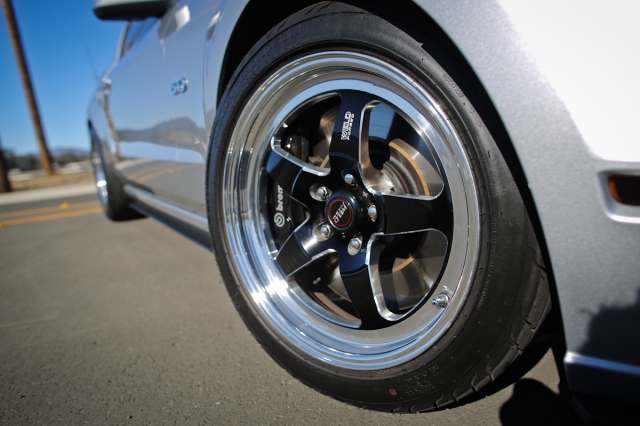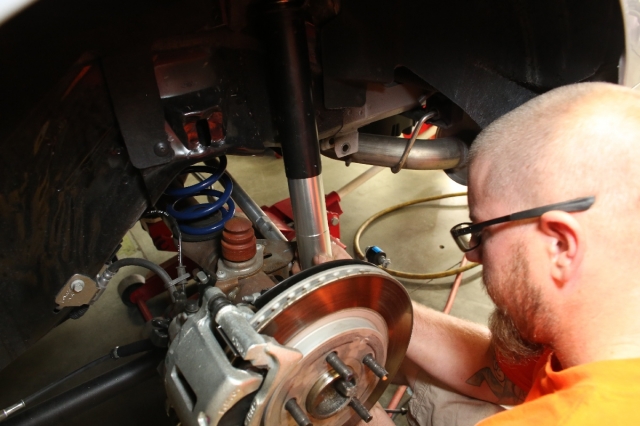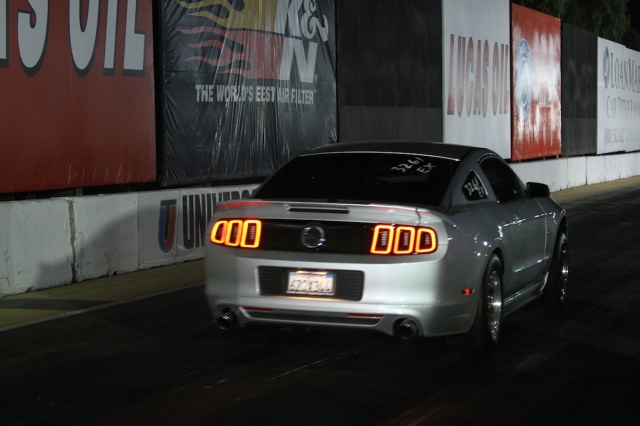Thanks to the aftermarket, improving the dragstrip performance on a late-model Mustang is just a matter of removing the factory suspension parts and installing capable aftermarket bits. Our Project Silver Bullet has been the recipient of a number of upgrades so far in its short life, from a Roush Performance Phase 2 supercharger system along with a set of Kooks Custom Headers 1 7/8-inch headers to go with their X-pipe to free up the exhaust – the car is now pumping out plenty of power to where we can take advantage of a street/strip type suspension to help our short times.
Considering all of the performance improvements we’ve made to date, we’ve decided to build a second “setup” for dragstrip performance, and to that end, we’ve enlisted the help of Strange Engineering and American Muscle to help the car’s performance on the track. We’ve got before-and-after testing results included, showing just how much improvement we’ve gained through installing the correct parts for dragstrip performance on the Silver Bullet.

Weld Racing S71 wheels combine with Mickey Thompson drag radials and the new rear springs to give Silver Bullet a wicked stance.
There are many tuner shops and individual racers that work hand-in-hand with aftermarket companies to figure out what settings work for each individual part. Strange Engineering has been at the forefront of Mustang suspension development for many years thanks to the parts they’ve developed in conjunction with those tuners who are flogging the Mustang chassis on the strip on a regular basis.
Controlling Motion
As the chief pieces of the suspension responsible for controlling unwanted movement, the shocks and struts are perhaps the most critical components to replace when dragstrip performance is the ultimate goal. It’s basically a given at this point that most Mustang enthusiasts are going to replace the stock rear control arms (which we did as part of the Maximum Motorsports segment of the project), so the next turn is into the damper and spring direction.
Left - Our assortment of new parts prior to installation. Right - The Strange Engineering double-adjustable bolt-in aluminum rear shocks provide adjustment for both rebound and compression - critical in a car equipped with drag radials like Silver Bullet.
In an effort to help the massive group of Mustang owners who are trying to achieve the same type of strip performance, Strange Engineering has built a set of bolt-in, adjustable shocks and struts to simplify the process.

The Strange single-adjustable strut will provide us with the perfect amount of adjustment to control the car’s performance at the track.
Their bolt-in, single adjustable steel-bodied front struts for 2005-14 Mustangs (2005-10 PN S6009LM, ’11-’14 PN S6011LM) achieve the goal of controlling front end rise and settle through proprietary valving developed through dozens of hours of dragstrip testing. There are ten adjustment positions on the single knob to cover a wide range of applications from street to strip.
“Our front struts for the stock mount spring design in the Mustang are single-adjustable on the extension side only. They help to control weight transfer and rise of the nose, as that’s where the critical adjustment is on these cars,” says Strange Engineering’s JC Cascio.
Now that we’ve got the front end out of the way, it’s time to move to the rear. Unlike the single-adjustable steel-bodied front struts, we’ve decided to install a set of Strange’s aluminum-bodied double-adjustable shock absorbers on the rear of the car [PN S5042].
Left: Installation of these is just like any Mustang front suspension of the last decade - A coil-over spring arrangement atop the stock-replacement strut design. Four bolts at the top remove the strut mount. Middle: We're using the Maximum Motorsports caster/camber plates that came with our Road and Track Grip box atop the Strange struts. Right: Two bolts at the bottom of the strut for removal and reinstallation. Make sure to torque these properly - you don't want the bolts coming loose.
These are very similar to Strange’s proven coil-over technology used in big-dog drag radial and heads-up cars, but are sold in a smooth-body, stock-mount design for this application. The monotube design offers consistency on the track when it’s needed most. Adjuster knobs are easily accessible at the base of the shock, with ten positions for each knob (one on each side), and polyurethane bushings reside at each end to control unwanted movement.
Left: The rear shocks take a little bit more work to install properly. Support the rearend with a jack and a pair of jack-stands. Left Middle: As you can see, this ear on the stock shock bracket interferes with the adjuster knob on the outboard side of the shock. It needs to be cut or ground off to install them properly. Right Middle: The bracket with the ear removed. Right: The rest of the installation proceeds as normal. Pull down on the rearend housing to remove the spring, put the new one in its place, and reinstall the shock.
Damper Valving
Shock valving has been developed through testing – the initial valving is created from the stock valving with adjustment in each direction. Changes to that initial design are then made based on feedback from their customers in the field that spend countless hours testing the product and providing real-world feedback.
From there, the Strange R&D team optimizes the valving for the conditions each particular shock will see on the track. Design, manufacturing, valving, and damper dyno testing are all done in-house at Strange Engineering.
“Our double-adjustable shocks control both compression and extension. When the car launches, it’s essentially trying to throw the rear end at the ground. The extension of the shock controls how hard you plant the tire – if you don’t plant the tire enough, you’re going to spin. If the shock is run stiffer, it won’t transfer the weight as easily, and you’re more prone to spinning. On the other side, if the shock is too soft, or too aggressive, it will throw the tire at the ground really hard. That’s more than the car can handle, and you’ll get into tire shake or hop, or with slicks, it’ll actually compress the tire sidewall and bounce the rim off the ground. You have to find the happy medium,” explains Cascio.
Being able to control the car’s motion is critical to ensuring that the tire sticks both at the launch and down the track – having it do one, but not the other, is what racers spend the majority of their time chasing, and one of the things that makes shock adjustment so challenging, especially for a new racer.
“Now you start dealing with weight transfer of the car. Compression controls how the body settles, and how the tire is planted after the initial hit. If you’re the type of racer who’s checking conditions, how many runs are on your slicks, what types of dips and bumps are in the track to where you’re going to start logging all of these things and making adjustments as you go, then a double-adjustable shock is for you – it will give you the ability to fine-tune everything. For the majority of racers who like to find a setting that works on their car and then don’t want to touch it, our single-adjustable steel-bodied shock [PN S6008LM] is for you,” says Cascio.
The Spring’s The Thing
Now that we’ve got the damper selection out of the way, we turn to the coil springs. Instead of trying to reinvent the wheel, we hopped on the phone with the folks at American Muscle in Pennsylvania to see what’s worked best for them in an application like ours. They were quick to point us in the direction of – if you can believe it – factory-style parts.
For our application, they felt we’d benefit most from using a Ford Racing Parts Cobra Jet drag spring kit [American Muscle PN 50411], which is a set of four coil springs that have been developed specifically for use on the 2013 Ford Racing Cobra Jet.

Swapping the rear springs and shocks can be done on the ground with a pair of jackstands and a jack – once the shocks are out of the way, simply pull the spring, swap the isolator to the new spring, and reinsert. Shocks are a bolt-in.
In case you’ve been living under a rock, the Cobra Jet is the limited-edition, incredibly successful, factory-built race car that Ford’s been offering since 2008. Many of the products that were developed for the CJ have found their way into the Ford Racing Parts catalog, including these springs.
The extension of the shock controls how hard you plant the tire – if you don’t plant the tire enough, you’re going to spin. – JC Cascio, Strange Engineering
The springs are exclusively made for Ford Racing by Eibach and are precision engineered to provide maximum traction to the rear wheels through proprietary spring rates. They’ll fit 2005-’14 Mustangs including the GT, Bullitt, Boss 302, and GT500 models and are designed for drag racing only – don’t try carving up the twisties with these puppies. Installing a set will lower the front around 1.75 inches and the rear of the car about an inch.
One note to mention – after initial track testing with the car, we found that the front spring design was not perfect for the heavy front-end weight of the supercharged Silver Bullet, and we swapped the front springs back out for the stock pieces. Remember that the Cobra Jet is a racecar that has slicks on the back and a transbrake in the transmission that allows the Cobra Jet to launch more aggressively. Since we’re working with drag radial tires and our foot brake to load up the torque converter, the suspension dynamic changes a bit. Also, we’re working with a full-weight street car that’s had a bunch of additional weight added to the nose with the RoushCharger. Having the stock springs sitting up higher allowed for better weight transitioning to the rear tires in our situation.
Removing Rotating Weight
We also collaborated with the folks at American Muscle to reduce quite a bit of rotating weight in the form of a Driveshaft Shop one-piece 3.5-inch driveshaft [American Muscle PN 13953] for Silver Bullet. Driveshaft Shop is the exclusive supplier for all American Muscle driveshafts, so you know they are top quality!
There’s a 1350 front U-joint with the proper transmission mating flange and a 6061-T6 aluminum shaft section that’s rated for 3,450 foot-pounds of torque. The shaft’s ends are welded on using the Driveshaft Shop’s auto-feed machines to provide strong, consistent welds throughout.
The high speed 108mm CV mount at the rear end of the shaft uses a 300M splined section that has a special boot and grease for long life. In addition, all hardware is included including a custom conversion plate that’s corrosion plated to change from the stock Ford CV unit to the DSS 108mm version.
According to The Driveshaft Shop’s Daniel Frank, “For the last 6 years we have been trying to make a driveshaft for the new S197 Mustang that is not only the strongest shaft out there, but also the most stable shaft when it comes to dealing with the harmonic vibrations that these cars are plagued with. In our opinion these cars were rushed to market with a harmonic vibration in the drivetrain. This is very obvious with the stock two-piece 43-pound anchor of a driveshaft that came installed in the car to help cure the problem. For those who are not aware, the rear of the factory shaft has a 9 pound steel damper inside of the tube helping to make it so tremendously heavy.”
The shaft is high speed balanced at over 9,000 rpm, carries a one year warranty, and is rated for 900 horsepower. Since we don’t have aspirations of achieving that with Silver Bullet, we’ve got a healthy cushion and shouldn’t have to worry about this bad boy ever.Their product eliminates the issues caused by the stock shaft and adds plenty of horsepower capability. It’s built in-house in The Driveshaft Shop’s facility in North Carolina.
A reduction in rotating weight plus an increase in strength makes the installation of this one-piece driveshaft a no-brainer.
How Does It All Work?
We finally got the car back to the track a short time ago, and while the results definitely weren’t ideal, we’ve got a solid base to move forward with into the future. In our testing, the car turned in improved short times but didn’t carry the improvement through to the quarter-mile, due to a slipping supercharger belt we discovered at the track. Our testing in this configuration netted a 1.54 short time and 6.88 at 102 mph.
That’s an improvement over our previous best 60-foot time of 1.58, but the top-end charge suffered substantially due to the belt issues. We feel that once we get the belt-slippage problem corrected (which we’re in the process of doing right now), the car should turn in 1.46-1.48 short times and much-improved elapsed times as a result.
So we know the suspension is working more efficiently, but we have to get the belt issues corrected before we can get a true feel for just how much we’ve improved. We’ll be back soon with an update on the car as soon as we can get that accomplished.
































